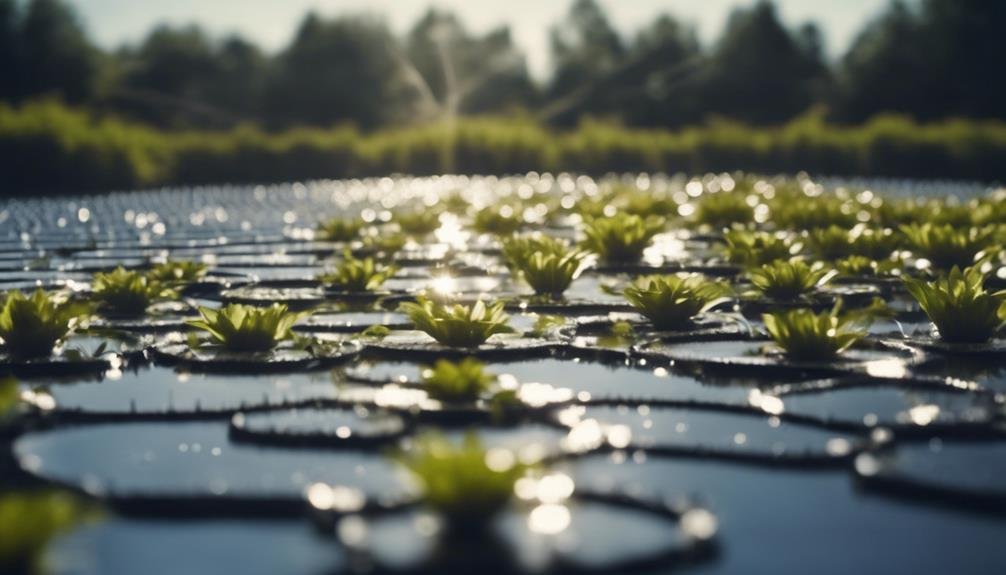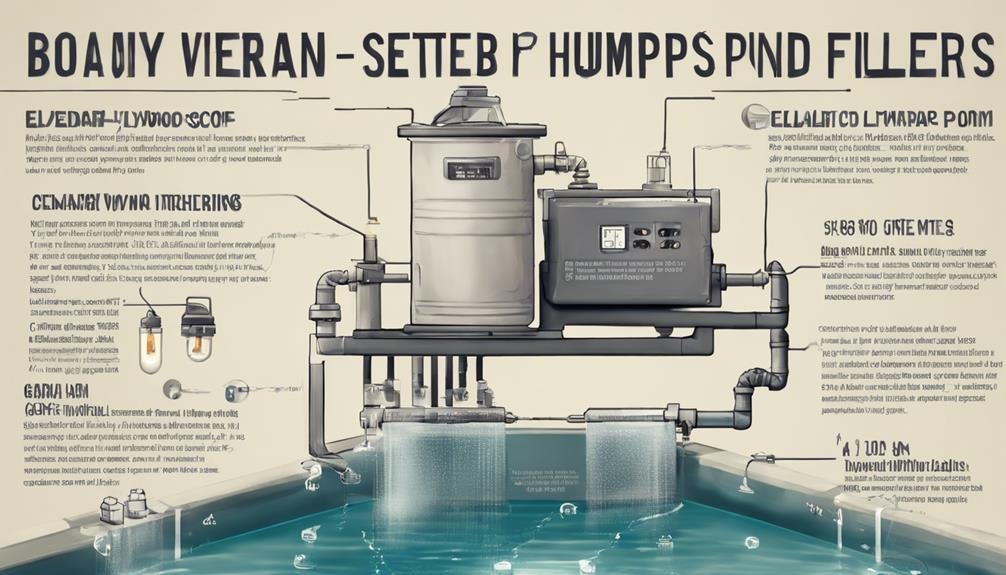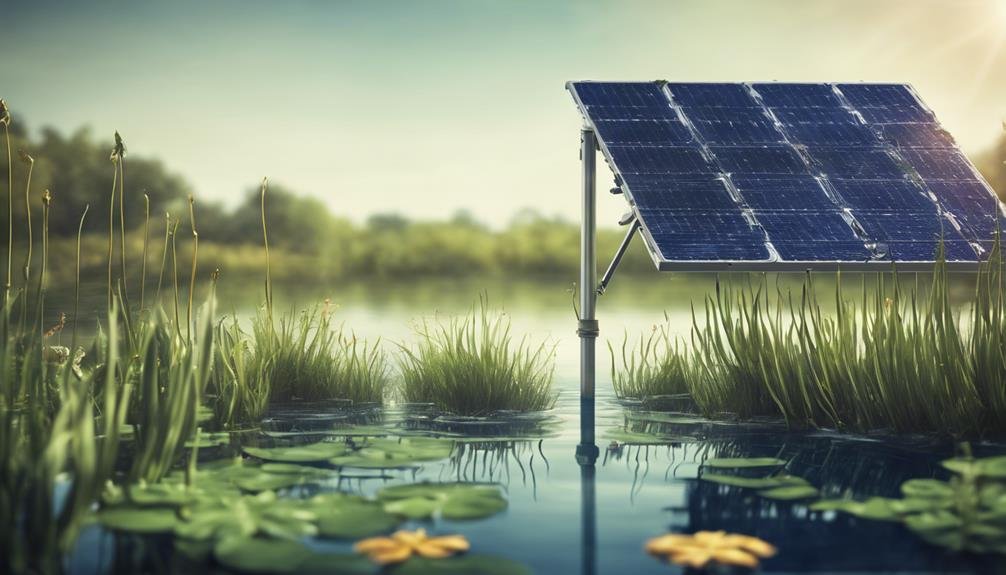Harnessing solar energy to power pond equipment like pumps and aerators is a sustainable and cost-effective solution. Solar panels capture sunlight and convert it into electricity, which can be stored in batteries for continuous usage. It is crucial to size the system correctly by matching the panels and batteries to our energy needs.
Some of the links in this article may be affiliate links. If you make a purchase through these links, we may earn a small commission at no extra cost to you. Thank you.
A well-designed solar setup not only reduces electricity expenses but also helps in lowering our carbon footprint. By switching to solar power, we can eliminate the noise from generators and minimize our environmental impact. With proper installation and regular maintenance, solar energy can provide reliable, long-term power for maintaining healthy ponds.
Transitioning to a solar-powered pond system offers numerous benefits. By utilizing the sun's energy, we can operate our pond equipment efficiently without relying on traditional power sources. This not only saves money in the long run but also contributes to a cleaner and greener environment.
Additionally, solar-powered systems require minimal maintenance once installed correctly, making them a hassle-free solution for pond maintenance. Investing in quality solar panels and batteries ensures consistent power supply, promoting the overall health of the pond ecosystem. Consider exploring specific solar products tailored for pond maintenance to optimize energy efficiency and performance.
Solar Panel Installation
When setting up solar panels to power pond equipment, thorough planning and precise execution are essential for optimal performance and longevity. It's crucial to assess the sunlight availability, determine the right system size, and select top-quality components to ensure consistent operation.
To begin, a careful evaluation of the pond's surroundings is necessary to identify the ideal placement for the solar panels. Factors such as potential shading from nearby structures or trees and the panels' alignment with the sun will influence their effectiveness. Additionally, calculating the energy needs of the pond equipment is crucial for sizing the solar array appropriately.
Choosing durable and weather-resistant solar panels specifically designed for outdoor use is vital. These panels should be securely mounted on a robust framework angled towards the sun to maximize exposure. An adequately sized charge controller must be purchased to regulate the energy flow from the panels to the batteries, preventing any risk of overcharging.
The use of deep-cycle batteries specifically designed for solar applications is recommended to store the energy for later use. Proper maintenance of these batteries, including monitoring water levels and ensuring clean connections, will significantly extend their lifespan.
Powering Pond Equipment
Now that the solar panels are in place, let's focus on powering the various equipment required for maintaining your pond. By storing the solar energy collected during the day in batteries, you can operate pumps, aerators, and other devices whenever needed. It's essential to know the power needs of your equipment and choose batteries with the right capacity to ensure efficient and dependable performance.
Understanding the power requirements of your pond equipment is crucial for ensuring smooth operation. For instance, a pond pump may need a certain amount of energy to circulate water effectively, while an aerator requires a different power level to oxygenate the water. By selecting batteries with sufficient capacity to meet these needs, you can avoid interruptions in your pond maintenance routine.
When it comes to battery options, consider reliable brands like Goal Zero or Renogy, known for their quality and durability. These batteries can store the solar energy efficiently and provide a consistent power supply for your pond equipment. Investing in high-quality batteries won't only enhance the performance of your pond devices but also increase the overall reliability of your solar-powered system.
Solar Panel Installation
To power pond equipment using solar energy, we need to install solar panels correctly. First, we'll assess the energy needs of our pond equipment and calculate the required solar panel wattage. Then, we'll pick an optimal location for the solar panels, taking into account factors like minimal shading, orientation towards the south (for the northern hemisphere), easy maintenance access, and proximity to the pond equipment.
Once the location is chosen, we'll securely install the solar panels, ensuring they're angled correctly to receive maximum sunlight exposure. Additionally, we'll set up the necessary wiring and electrical components, including charge controllers and batteries, to efficiently store and distribute solar energy. It's essential to confirm proper grounding and safety measures, install overcurrent protection devices, and provide ventilation for battery storage areas.
Battery Storage Options
When choosing a battery storage solution for your solar-powered pond equipment, it's crucial to consider factors like energy requirements, discharge rates, and long-term reliability.
Lead-acid batteries are a popular choice due to their affordability and widespread availability. However, they need more maintenance and have a shorter lifespan compared to other options.
On the other hand, lithium-ion batteries, although pricier upfront, boast higher energy density, longer lifetimes, and lower maintenance requirements.
Saltwater batteries, utilizing saltwater electrolytes, offer a longer lifespan than lead-acid batteries and are environmentally friendly. While they may come with higher initial costs, their durability and eco-friendliness make them a worthy investment.
For larger installations, flow batteries storing energy in liquid electrolyte solutions provide excellent capacity and longevity.
Regardless of the battery type chosen, proper sizing and installation are essential. Calculating the energy needs of your pond equipment, considering daily usage patterns and potential downtime, is crucial.
Consulting experts can help you select the most suitable, cost-effective, and durable battery solution for your solar-powered pond system.
Energy Efficiency Benefits

Let's explore the significant energy efficiency advantages of utilizing solar power for pond maintenance.
By tapping into renewable solar energy, we can greatly reduce electricity expenses and lessen our carbon footprint, resulting in substantial long-term savings.
It's crucial to grasp these benefits to make informed choices regarding sustainable pond management.
Reduced Electricity Costs
Switching to solar energy for pond maintenance offers a cost-effective solution to reduce electricity expenses significantly. By utilizing solar-powered pumps and aerators, pond owners can eliminate the need for grid electricity, leading to long-term savings. The benefits of using solar energy include no monthly electricity bills, low operational costs post initial investment, eco-friendliness, and reliability during power outages.
Solar systems for ponds are easy to maintain, further cutting down on expenses. Calculating potential savings involves considering the pond's energy requirements, local electricity rates, and the cost of solar equipment. With advancements in solar technology, efficient and affordable pond maintenance can be achieved while also supporting sustainability.
Lower Carbon Footprint
Switching to solar energy for pond maintenance significantly reduces our carbon footprint, promoting a cleaner environment. By shifting away from fossil fuels, which emit greenhouse gases when burned, we're helping combat global warming and climate change.
Solar panels, located near the pond, directly convert sunlight into electricity without the harmful emissions associated with traditional power sources like coal or natural gas. This sustainable system not only minimizes air pollution but also harnesses the sun's renewable energy, which is abundant and eco-friendly.
Solar power offers a reliable and virtually unlimited energy source, with the sun providing more energy in an hour than the world consumes in a year. By utilizing this clean energy for our pond equipment, we're making a positive impact on sustainability.
Our solar-powered maintenance practices not only improve water quality but also contribute to a greener future by reducing our reliance on non-renewable resources. It's a proactive step towards environmental conservation and ensuring a healthier ecosystem for our pond.
Long-Term Cost Savings
Making the switch to solar power for pond maintenance requires an initial investment but offers significant long-term savings due to improved energy efficiency. By utilizing solar energy, we reduce our dependence on fossil fuels, leading to lower utility costs and a more sustainable approach to powering our pond operations.
The cost savings over time include minimal maintenance expenses for solar panels, stable energy costs without fluctuations in fuel prices, potential tax benefits for using solar power, and long-lasting panels that can provide reliable energy for many years.
In addition to the financial benefits, solar energy is a clean and environmentally friendly power source that aligns with our commitment to sustainability. By transitioning to renewable energy solutions, we not only decrease our carbon footprint but also protect against potential rises in traditional energy expenses.
Embracing solar power is a wise investment in a cost-effective and eco-conscious solution that pays off in the long run.
Environmental Impact Reduction
Switching to solar energy for pond maintenance tasks like aeration and filtration significantly reduces greenhouse gas emissions compared to using fossil fuels. This shift helps minimize our environmental impact by decreasing reliance on non-renewable energy sources that harm the environment. Solar-powered systems also eliminate the need for noisy generators and power lines, preserving the natural peace of the pond ecosystem while reducing risks of contamination.
By embracing solar power, we not only protect local flora and fauna from disturbances but also contribute to global efforts in combating climate change. Solar energy production itself has a minimal carbon footprint, making it a sustainable alternative to traditional power sources.
Making the switch to solar-powered pond maintenance aligns with our commitment to eco-friendly practices and environmental stewardship, benefiting both the immediate pond area and the planet as a whole.
Cost Savings Analysis

Switching to solar-powered pond maintenance presents significant cost savings in the long run. Although the initial investment in solar equipment may appear high, the savings from reduced energy bills and low operational costs will quickly offset these expenses.
Solar energy offers several ways to cut costs effectively:
- By harnessing free solar power, we can eliminate electricity bills.
- Solar panels require minimal maintenance compared to fossil fuel generators.
- With proper care, solar panels can last over 25 years, contributing to long-term savings.
- There may be opportunities for tax credits or rebates for installing renewable energy systems.
Over the lifespan of a solar pond system, these cost savings add up considerably. While detailed financial forecasts can quantify the return on investment, the general trend is evident – solar energy significantly reduces long-term expenses.
Maintenance and Upkeep
To ensure the solar-powered pond systems operate efficiently and last long, it's crucial to keep up with proper maintenance. Regularly check the solar panels to ensure they're clean and free of any obstructions like dirt, leaves, or bird droppings that could block sunlight. Gently clean the panels to maintain optimal energy absorption.
Routine maintenance of the pond pump and filters is essential. Follow the manufacturer's guidelines to clean or replace the filters to prevent clogging and ensure proper water circulation. Monitor the pump's performance regularly and replace it if it starts to underperform or fails.
Keep an eye on the battery bank's charge levels and water levels, topping them up when necessary. Trimming vegetation around the solar panels is also important to prevent shading and ensure they receive maximum sunlight exposure.
Solar Panel Sizing

When it comes to sizing solar panels for your pond equipment, precision is key to ensuring they meet your energy needs efficiently. Factors such as the power requirements of your pumps, filters, and other electrical devices, along with the local climate conditions and average daily sun exposure, must be taken into consideration. It's also important to plan for battery backup capacity in case of cloudy days or emergencies, as well as any potential future expansions or additional energy needs.
To accurately size your solar panels, you should start by estimating the total watt-hours of energy used by all your pond equipment each day. Based on this calculation, determine the panel wattage required considering the hours of sunlight available and the desired battery reserve. It's recommended to choose panels with a rating at least 25% higher than the minimum wattage needed to accommodate any inefficiencies in the system.
If you're unsure about the sizing process, consulting a solar professional for expert guidance on system design is advisable.
Getting the right size of solar panels from the beginning is essential for maximizing efficiency and optimizing your investment.
In the next section, we'll delve into specific methods for calculating the ideal solar panel size for your pond setup.
Monitoring and Optimization
Monitoring the performance of solar panels is crucial for maximizing energy production and ensuring system reliability in the long run. By tracking key metrics such as power output, energy generation over time, and overall efficiency, we can proactively identify any issues and take necessary corrective actions. Additionally, monitoring helps us understand how external factors like weather conditions and shading impact the system's performance.
Most solar monitoring systems offer user-friendly online dashboards or mobile apps, allowing us to easily access real-time and historical data. Setting up custom alerts for low output enables us to receive notifications promptly in case of any potential problems. By analyzing this data over time, we can assess how well our system is performing compared to its expected specifications.
Regular monitoring isn't only essential for troubleshooting but also for optimizing the system. The insights gained from monitoring can help us make informed decisions such as adjusting panel orientation, upgrading components, or expanding capacity if needed. With diligent tracking and strategic optimizations, we can ensure that our solar panel system operates at peak efficiency for years to come.
Conclusion
Harnessing solar energy for pond maintenance is like planting the seeds for a sustainable future. Each solar panel brings us closer to creating a thriving oasis where aquatic life flourishes, and our dedication to protecting the environment sings in harmony with nature's tune.
By utilizing solar power for pond upkeep, we reduce our reliance on traditional energy sources, decreasing our carbon footprint and promoting a healthier ecosystem. The panels absorb sunlight and convert it into electricity, powering pumps and filters that keep the water clean and balanced. This sustainable approach not only benefits the pond's inhabitants but also contributes to a greener planet for future generations to enjoy.
One excellent product recommendation for solar-powered pond maintenance is the Solar Pond Aerator. This innovative device harnesses the sun's energy to oxygenate the water, promoting the growth of beneficial bacteria and supporting a balanced ecosystem. By incorporating such technology, pond owners can take a proactive step towards sustainability while reaping the rewards of a vibrant and healthy aquatic environment.

